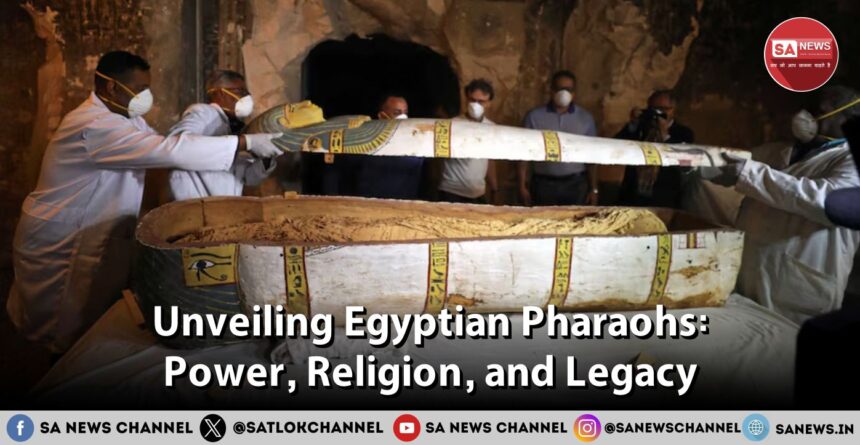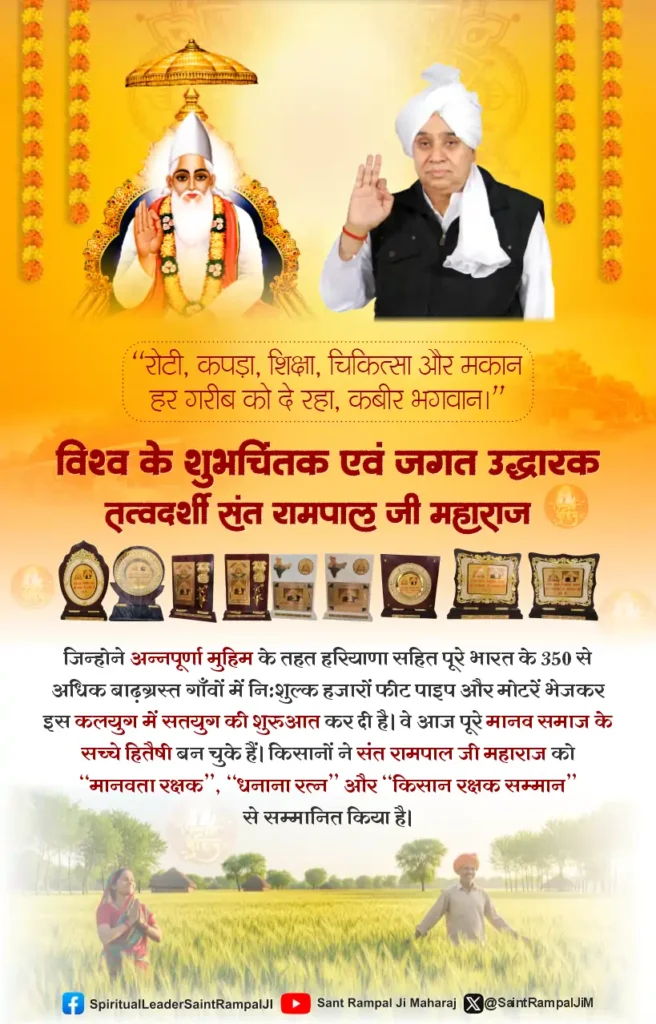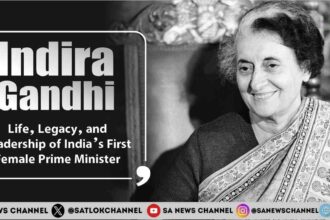Each one of us remembers the Pyramid of Giza, don’t we? We know that these are tombs of the Pharaohs and the royal family. But do you have an idea of who the Pharaohs were? When we talk of Pharaohs, the images of golden crowns, jewelry, and crooks and flails immediately come to mind. But do you know what was the reason behind the colossal power of the Pharaohs?
- The Role and Duties of Pharaohs
- Pharaoh’s Attire and Symbolism
- Crowns: Authority and Unity
- Jewelry and Amulets: Protection and Divine Favor
- Royal Scepters, Crook, and Flail: Authority in Symbols
- Clothing and Headdresses: Representation of Status
- Famous Pharaohs and Their Contributions (Tutankhamun, Ramses II, etc.)
- Decline and End of Pharaoh Rule
- Saint Rampal Ji: The Social Reformer and Tatvadarshi Saint
If not, don’t worry, in this blog we will cover all this and much more about the ancient Egyptian Pharaohs: their power, religion, and legacy. This journey of the Pharaohs started at the beginning of the dynastic era, with the unification of Upper and Lower Egypt around 3100 BCE, giving birth to a single throne and the first dynasty. From this time onwards, the ruler was not just an ordinary king – he became the sacred pulse of the kingdom.
Like the evolution of kings from just rulers to being divine figures, the evolution of the title ‘Pharaoh’ is also interesting. This title was not originally used for the kings but it evolved on its own. The word Pharaoh is taken from the ancient Egyptian phrase per-aa, meaning “great house,” which originally referred to the royal palace before becoming synonymous with the king himself. This shift in language reflected how inseparable the Pharaoh’s identity became from Egypt’s very soul. To the people, Pharaohs were not just ordinary rulers, but living gods. They were symbols of strength, wisdom, and eternal order.
The Role and Duties of Pharaohs
Pharaohs not only enjoyed absolute authority over the state but also were the highest decision-makers in government in various matters of law, order, and administration. The rule of the Pharaohs was perceived as divinely sanctioned, making disobedience not just a political crime but also a spiritual offense. Being the ultimate source of justice, it was the duty of the Pharaoh to maintain ma’at – the balance of order, harmony, and truth. The officials, governors, and scribes appointed by the Pharaohs worked under their authorization, ensuring that Egypt’s wealth, from trade to agriculture, assisted the prosperity of the land.
Military Leadership and Defense of Egypt
Besides being the rulers of the land, Pharaohs were also the military commanders. They ensured the protection of Egypt’s borders. Pharaohs also commanded armies during war, led campaigns against invaders, or conducted battles to expand Egypt’s rule. Great Pharaohs such as Ramses II eternalized their victory through inscriptions and temple reliefs, linking their military achievements to divine favor.For ancient Egypt, the defense of the Nile Valley was very crucial.
The Nile not only provided land and resources but also was the source of treasure and wealth for Egyptians. Pharaohs enhanced their image as guardians of the people and protectors chosen by the gods by protecting Egypt from foreign threats and establishing rule over surrounding regions.
Religious Duties: Pharaohs as High Priests
Pharaohs served as the mediators between the gods and the humans of Egypt. They were the chief Priests of Egypt. It was the duty of the Pharaohs to oversee and perform sacred rituals. They not only presided over major festivals and ensured offerings were made to the gods but also commissioned temples to honor divine powers. Even though the daily rites were conducted by the priests, it was always in the Pharaoh’s name, which only reinforced his position as the gods’ intermediary.
Also Read: The History of the Phoenicians: The Seafaring People
Pharaohs were often associated with the Egyptians gods such as Horus during life and Osiris in death, sustaining the unity of the spiritual and earthly realms. Pharaohs, by maintaining the gods’ favor through ritual and sacrifice guaranteed fertility, abundance, and stability for their land.
Pharaoh’s Attire and Symbolism
Pharaohs symbolised power with their elaborate attires. To denote authority and unity, Pharaohs wore the crowns of Upper and Lower Egypt, the nemes headdress, and the crook and flail. Pharaohs also wore protective amulets, gold jewelry, and even false beards, each strengthening their divine and eternal role as guardians of Egypt.
Crowns: Authority and Unity
A Pharaoh’s appearance was not only to beautify but also carried meaning, serving as a carefully crafted language of authority. The classical double crown, which merged the white crown of Upper Egypt with the red crown of Lower Egypt, was more than regalia—it was a symbol of unity under one divine king. With it, the Pharaoh stood as the living epitome of Egypt’s wholeness and power.
Jewelry and Amulets: Protection and Divine Favor
Pharaohs wore jewelry as a charm for the spiritual strength they held. Amulets shaped like ankhs, scarabs, or sacred animals carried blessings from the gods and were believed to protect the Pharaohs from danger and connect them with the gods’ favor. Each shining ornament was a symbol of prestige along with protection.
Royal Scepters, Crook, and Flail: Authority in Symbols
The crook and flail symbolised kingship. The crook depicted the shepherd guiding his people with care, and the flail signified the discipline and abundance needed to sustain them. The crook and flail, along with other royal scepters, were constant reminders of the Pharaoh’s role of nurturing rule with justice.
Clothing and Headdresses: Representation of Status
Clothing and headdresses demonstrated the Pharaoh as extraordinary, far away from the cycle of birth and death. The striped nemes headcloth, along with the uraeus cobra rising from the forehead, depicted divine protection and royal status.
Famous Pharaohs and Their Contributions (Tutankhamun, Ramses II, etc.)
Pharaohs left their legacy on stones. They created Pyramids, temples, and colossal statues symbolising worship but also as eternal symbols of power. These structures were not merely architectural marvels; but were living symbols of authority that carried within them innumerable stories of triumph, devotion, and quest.
Ramses II, called the “Great,” built monuments like Abu Simbel where art and architecture proclaim his power and ties to the gods. Ramses II stamped his reign with Egyptian military power, and his legacy continues to be tied to profound pride in Egyptian culture.
Even Tutankhamun—a ruler who reigned briefly—etched an eternal notoriety into his position by virtue of his tomb underground. The bountiful treasures that poured from inside his tomb strip away layers of what is known about the life and faith of royalty that captivates the world today and rekindles interest in Egypt.
And beyond the kings, beyond tombs, the Pharaoh created and shaped the makeup of Egyptian society. Whether an inclusive or exclusion function, the Pharaohs shaped every aspect of society, from art and religious ritual to contributions to architecture and administering the land they ruled.
Pyramids and temples were not constructed solely and exclusively for permanence but to sustain generations of Egyptians holding alive the significance of the Pharaohs, the very heart of Egypt, the stewards of its earthly dominion and its destiny.
Decline and End of Pharaoh Rule
The greatness of the Pharaohs came to an end with the foreign threat, political rivalry, and resource depletion. The Pharaohs of a once rich and unified land began to subdivide their power which exposed their weakened position to a foreign government. The wealth and culture of Egypt was enticing to the Persians, Greeks, and Romans who followed. The dynasties came and went, but with each conquest, the prestige of native rule was eroded little by little.
Cleopatra VII would become the last mainstream figure of a Pharaoh, desperately trying to retain the Egyptian legacy with diplomacy, through allegiances, and even her own allure. Her defeat at the hands of the Romans came with the end of Egyptian independence. Cleopatra’s demise also ended the legacy of Pharaohs, marking Egypt as an incorporated province under foreign control forever. Even in their decline, monuments, myths, and memories remained echoing across an age-long legacy full of Pharaohs, who would never ultimately be erased from history.
Saint Rampal Ji: The Social Reformer and Tatvadarshi Saint
Saint Rampal Ji Maharaj is the Tatvadarshi Saint and a social reformer in the true respect. Saint Rampal Ji provides the correct way of worship in accordance with the holy scriptures of all the sacred religions. Saint Rampal Ji also emphasizes worship that leads to salvation by chanting the true Naam (mantras) as revealed by Supreme God Kabir, free from rituals, idol worship, and blind faith. His mission includes spreading true spiritual knowledge to guide souls toward eternal liberation (Satlok).
Besides spiritual teachings, Saint Rampal Ji actively engages in social reforms, such as the abolition of the dowry system by encouraging His followers to perform dowry-free marriages. The Annapurna Muhim initiative by Saint Rampal Ji Maharaj provides food, clothes, education, medical care, and homes for the poor. Saint Rampal Maharaj is also providing vital support to flood-affected farmers in Punjab and Haryana by supplying motors and pipes to save their agriculture. Saint Rampal Ji’s combined efforts in spiritual upliftment and financial help to society showcase His mercy and selfless service for society.









